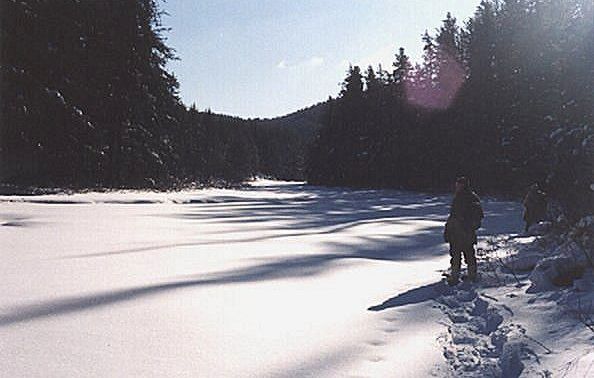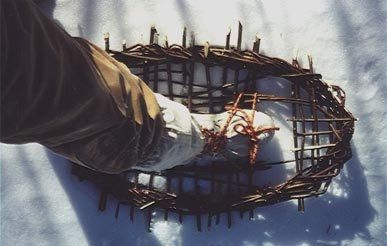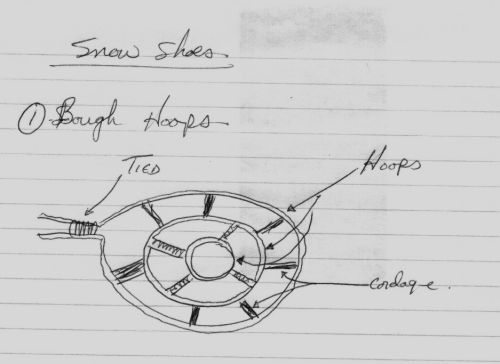 |
 |
|
|
Home →
Survival →
Winter
Snowshoes
|
|
 |
| |
| In the northern parts of North
America, snowshoes may be essential to travel through the wilderness in
winter. The snow can get so deep that it may be nearly impossible to walk
through. At the very least, it can take an enormous amount of effort to
walk without snowshoes. |
| |
How to make Primitive
Snowshoes
By Allan "Bow" Beauchamp
(Photos and text in this ection by
Allan "Bow" Beauchamp) |
| |
 |
Improvised snowshoes, made from materials
found in the bush. |
|
|
|
|
Here is a rough sketch of how to make primitive snowshoes |
|
|
|
 |
|
|
There are three basic methods for making primitive snowshoes:
- Brush snow shoes: Simply bend supple green bows as shoe hoops and
weave smaller hoops in the inner side and fasten these with cordage. Then
make foot holders from birch bark sheets, poplar bark, yellow birch bark,
clothing or cordage in between.
- Cordage snow shoes: Start with bent willows, and create a flat
webbing. Or heavy sasal rope as a woven "spider web".
- Sledge snow shoes: Using two long alders, and a couple of smaller
ones to open them up. Then make the cordage weaving for the inners! You can
use grass cordage bindings as I do for the foot fasteners, for the students.
Or simply make bark sheet snow shoes, with grass cordage. It's easy fun for
kids and good for light layers of snow!
|
|
|
Detailed step-by-step instructions for making snowshoes:
(Use the above sketch as a reference)
- Firstly, find a supple sapling and bend it as a hoop. Tie this at the
end. This is for the exterior hoop.
- Secondly, find a smaller supple sapling, bend it on itself and inner
weave itself onto itself so it makes a hoop.
- Thirdly, do the same step again as number two but use a still smaller
one.
- Now, lay the three hoops on the ground and use some cordage and tie the
second hoop to the first hoop. Remember you need a spot for your foot, so
put your foot on the second hoop and leave a place for your foot to go
through (the toe section needs to move freely). If you don't what I'm
talking about here, you need to first try on a pair of already-made
snowshoes and go for a walk (not the modern industrial kind, but the
original type made from wood). You will then quickly come to understand why
there is a need for a hole.
- Lastly, tie the third hoop to the second hoop, and check that where you
tied this hoop your foot will fit through. If it won't then retie the second
hoop cordage a bit wider at the front.
- Now, you have some choices:
- Put your foot on this structure, and envision where the extra space
is (the hole)
- If you know how to make grass cordage you can fill this in with the
thick grass cordage layer by layer.
- Or, you can take your T-shirt and put it over the whole structure
and cut two holes for your grass bindings, and tie the T-shirt where you
tied the first hoop end.
- Or, you can take birch bark strips and make a "weaved mat" and tie
this to the top of the framework (under your foot).
- Or, you can weave some supple boughs in an "over and under" fashion
across the top of the structure.
- Or, you can use a large garbage bag, and lay it on the top under
your foot, make ends by grabbing the bag, then take these ends and go
under the first loop wall and over again and tie the bag at the top
under your foot.
- So, some "simple" choices, and some "more work" choices, depending
on what you bring, what you have, your time frame, and what you are able
to fashion.
|
|
|
|
|
|
 |
|